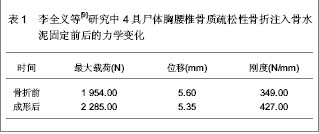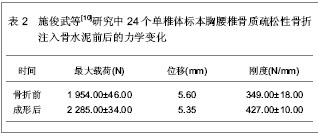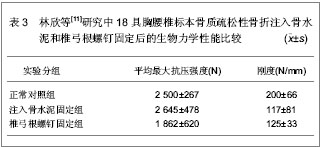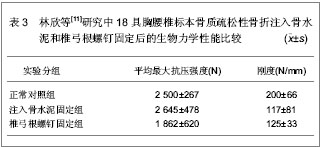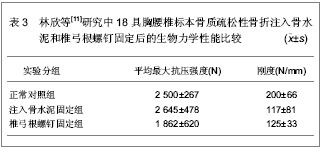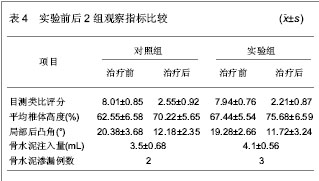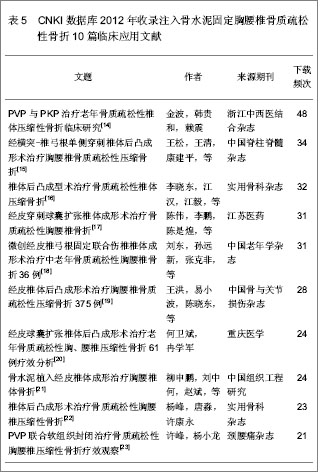| [1] Rao RD, Singrakhia MD. Painful osteoporotic vertebral fracture. Pathogenesis, evaluation, and roles of vertebroplasty and kyphoplasty in its management. J Bone Joint Surg Am. 2003;85(10):2010-2022.[2] 郑召民,李佛保.经皮椎体成形术和经皮椎体后凸成形术—问题与对策[J].中华医学杂志,2006,86(27):1878-1880.[3] 刘艺.经皮椎体扩张成形术治疗胸腰椎压缩性骨折患者的护理[J].实用临床医药杂志:护理版,2008,4(6):73.[4] Lane JM, Riley EH, Wirganowicz PZ. Osteoporosis: diagnosis and treatment. Instr Course Lect. 1997;46:445-458.[5] Wardlaw D, Cummings SR, Van Meirhaeghe J, et al. Efficacy and safety of balloon kyphoplasty compared with non-surgical care for vertebral compression fracture(FREE): a randomised controlled trial. Lancet. 2009;373(9668):1016-1024.[6] Hiwatashi A, Westesson PL, Yoshiura T, et al. Kyphoplasty and vertebroplasty produce the same degree of height restoration. AJNR Am J Neuroradiol. 2009;30(4):669-673.[7] 史成富,邹方亮,荆玉峰.经皮穿刺椎体注入骨水泥治疗老年骨质疏松性椎体压缩骨折[J].华北煤炭医学院学报,2009,11(2): 226-227.[8] 中国知网.中国学术期刊总库[DB/OL].2013-2-20.https://www. cnki.net[9] 李全义,李彩铃,刘时璋.骨质疏松伴胸腰椎骨折行自固骨水泥灌注成形术的力学研究[J].延安大学学报:医学科学版,2008,6(1): 27.[10] 施俊武,胡艇,池永龙,等.胸腰椎骨质疏松骨折行CPC灌注成形的力学实验[J].实用骨科杂志,2006,12(4):316-319.[11] 林欣,李家谋,张昆亚,等.经皮椎体成形术与椎弓根螺钉固定治疗骨质疏松性胸腰椎骨折的生物力学研究[J].中华创伤骨科杂志, 2006,8(9):861-863.[12] Lim TH, Brebach GT, Renner SM, et al. Biomechanical evaluation of an injectable calcium phosphate cement for vertebroplasty. Spine (Phila Pa 1976). 2002;27(12): 1297-1302.[13] Belkoff SM, Mathis JM, Jasper LE, et al. The biomechanics of vertebroplasty. The effect of cement volume on mechanical behavior. Spine (Phila Pa 1976). 2001;26(14):1537-1541.[14] 金波,韩贵和,赖震.PVP与PKP治疗老年骨质疏松性椎体压缩性骨折临床研究[J].浙江中西医结合杂志,2012,22(1):32-34.[15] 王松,王清,康建平,等.经横突-椎弓根单侧穿刺椎体后凸成形术治疗胸腰椎骨质疏松性压缩骨折[J].中国脊柱脊髓杂志,2012, 22(7): 622-626.[16] 李晓东,江汉,江毅,等.椎体后凸成型术治疗骨质疏松性椎体压缩骨折[J].实用骨科杂志,2012,18(3):241-243.[17] 陈伟,李鹏,陈是煌,等.经皮穿刺球囊扩张椎体成形术治疗骨质疏松性胸腰椎骨折[J].江苏医药,2012,38(8):960-961.[18] 刘东,孙远新,张克非,等.微创经皮椎弓根固定联合伤椎椎体成形术治疗中老年骨质疏松性胸腰椎骨折36例[J].中国老年学杂志, 2012,32(12):2641-2642.[19] 王洪,易小波,陈晓东,等.经皮椎体后凸成形术治疗胸腰椎骨质疏松性压缩骨折375例[J].中国骨与关节损伤杂志,2012,27(7): 589-591.[20] 何卫斌,冉学军.经皮球囊扩张椎体后凸成形术治疗老年骨质疏松性胸、腰椎压缩性骨折61例疗效分析[J].重庆医学,2012,41 (15): 1499-1500.[21] 柳申鹏,刘中何,赵斌,等.骨水泥植入经皮椎体成形治疗胸腰椎体骨折[J].中国组织工程研究,2012,16(29):5465-5468.[22] 杨峰,唐淼,许康永.椎体后凸成形术治疗骨质疏松性胸腰椎压缩性骨折[J].实用骨科杂志,2012,18(6):484-485.[23] 许峰,杨小龙.PVP联合软组织封闭治疗骨质疏松性胸腰椎压缩性骨折疗效观察[J].颈腰痛杂志,2012,33(1):43-44.[24] Lindsay R, Silverman SL, Cooper C, et al. Risk of new vertebral fracture in the year following a fracture. JAMA. 2001;285(3):320-323.[25] Belkoff SM, Maroney M, Fenton DC, et al. An in vitro biomechanical evaluation of bone cements used in percutaneous vertebroplasty. Bone. 1999;25(2 Suppl): 23S-26S.[26] Cloft HJ, Jensen ME. Kyphoplasty: an assessment of a new technology. AJNR Am J Neuroradiol. 2007;28(2):200-203. |
